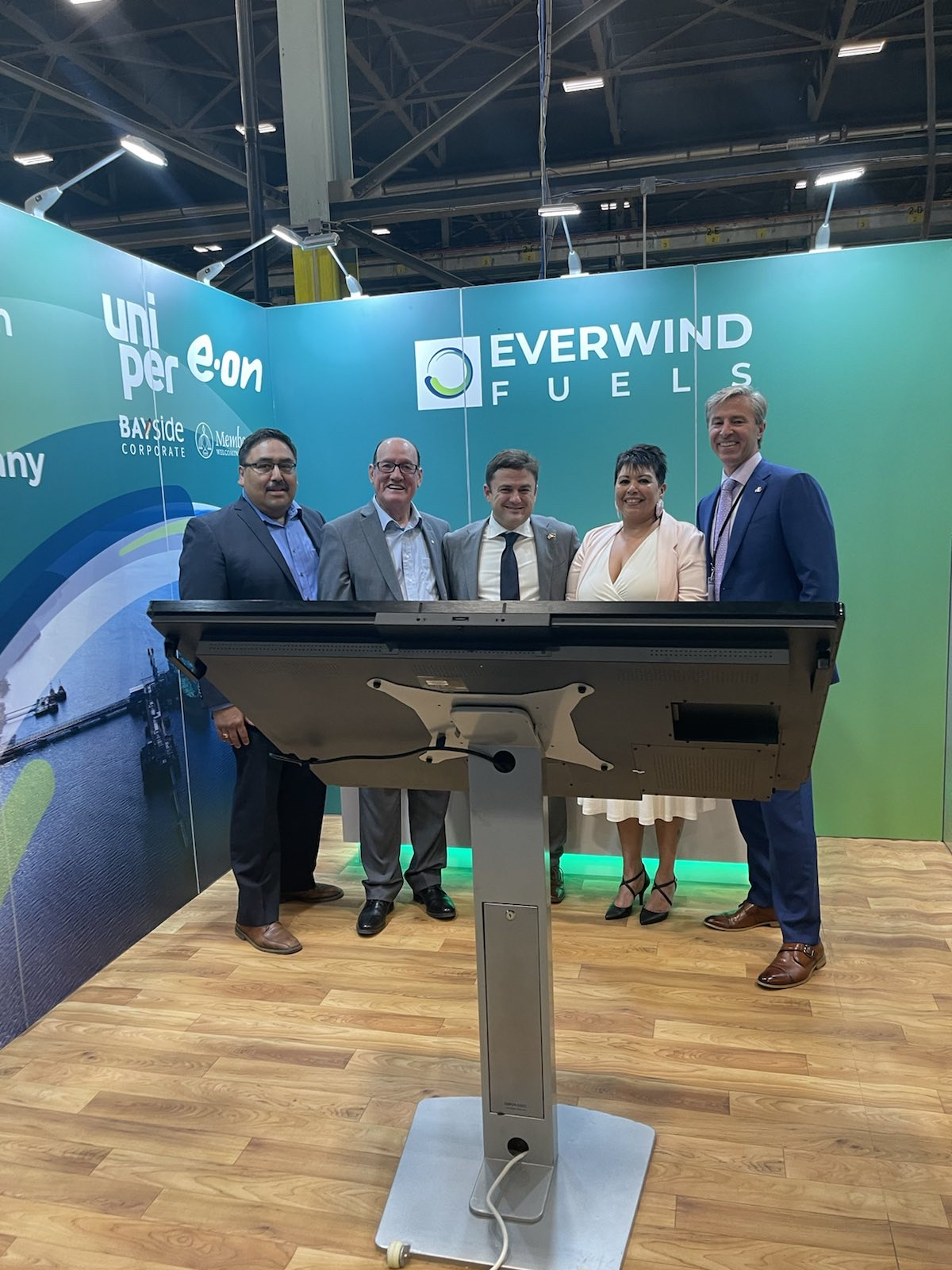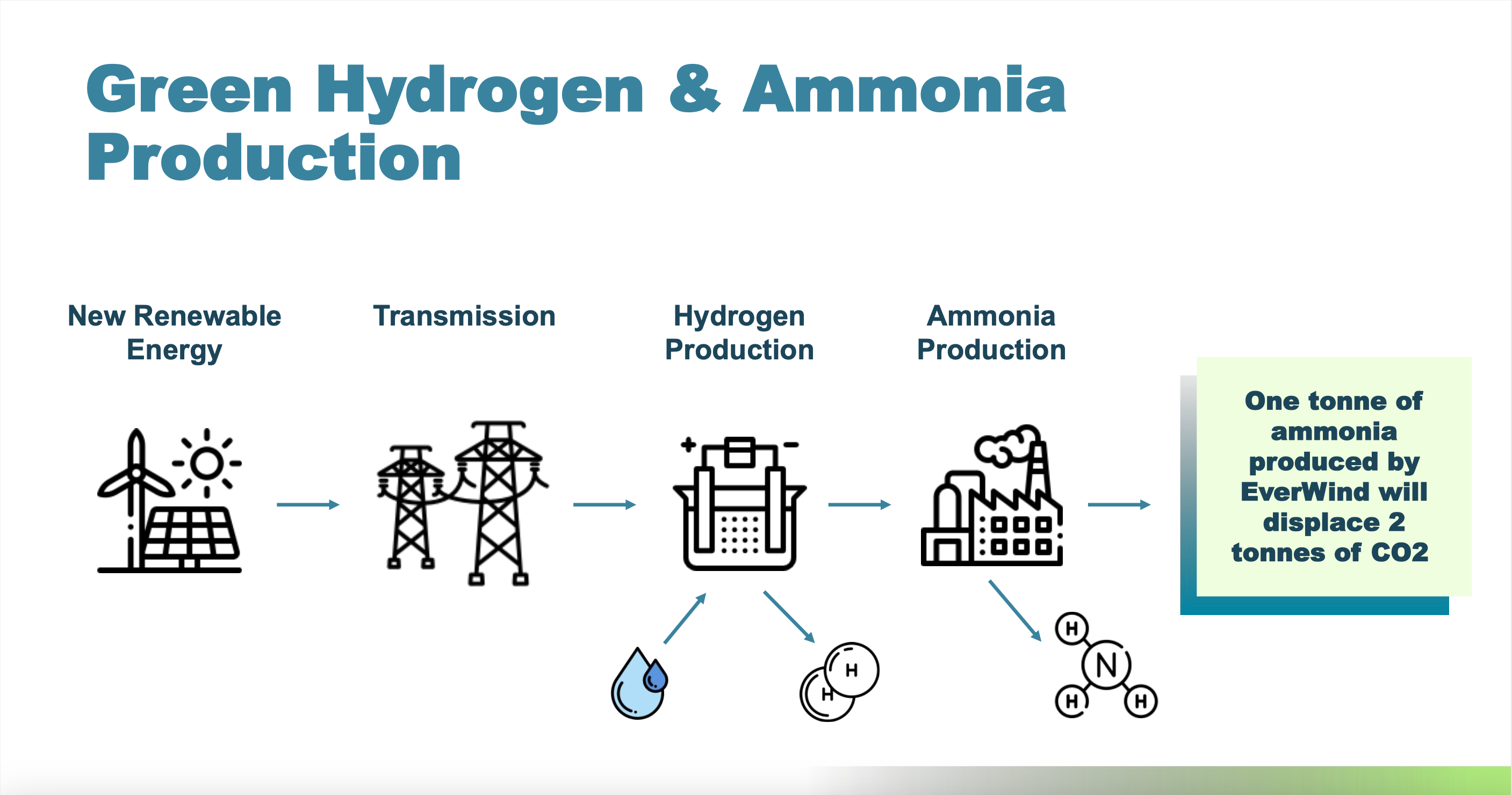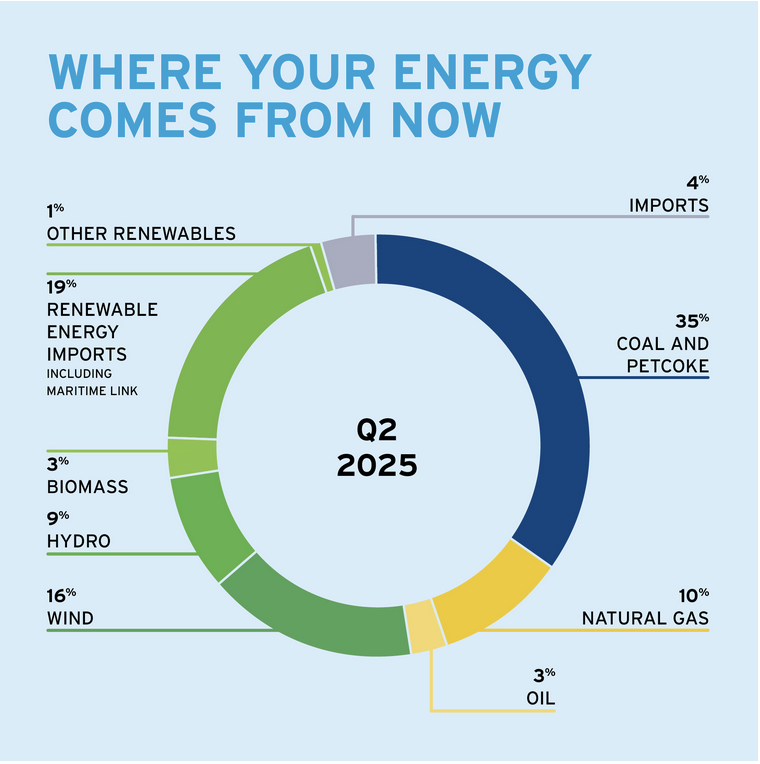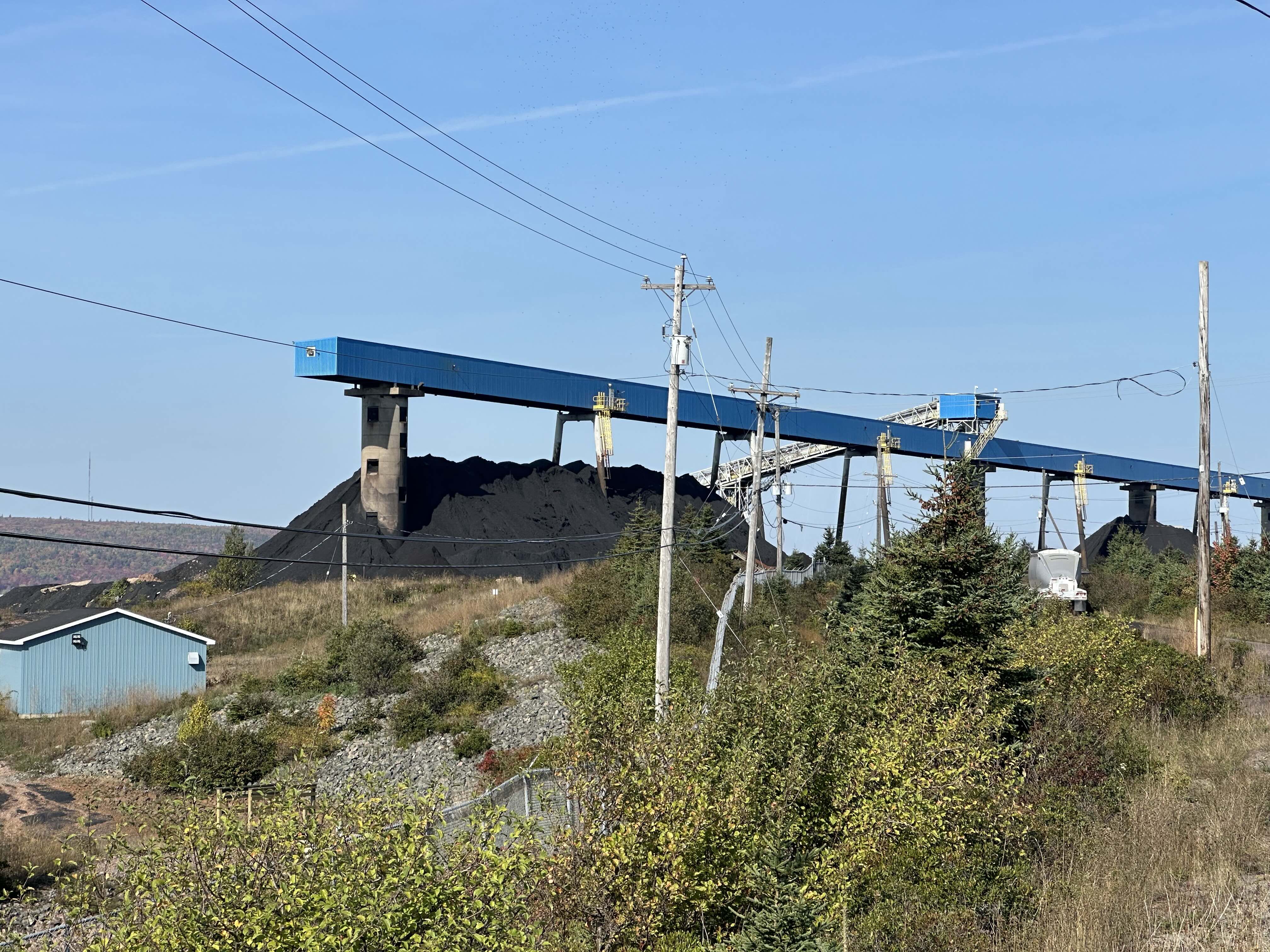This article was first published by the Halifax Examiner on Sept. 2, 2025.
On August 13, 2025, Kristen Overmyer submitted a complaint against EverWind Fuels to the Competition Bureau of Canada, alleging the company has been “making unsubstantiated and false, green claims promoting ammonia production from Nova Scotia renewable energy.”
According to Overmyer, a Nova Scotian with a masters degree in mechanical engineering, recent provisions made to Canada’s Competition Act prohibit “misleading representations commonly known as ‘greenwashing,’” and require “that any such claim be substantiated by proper tests or internationally recognized methodologies.”
Overmyer’s concerns stem from EverWind’s assertions that the hydrogen and ammonia it aims to produce in Point Tupper using electricity from wind projects it has planned in Nova Scotia will “mitigate climate change by reducing global CO2 emissions.”
Overmyer takes issue with, and offers detailed calculations, to allege that three EverWind claims are not just unsubstantiated, they are “misleading” to the public:
- EverWind Fuels will use only zero or low CO2 intensity, renewable energy in the production of their hydrogen and ammonia.
- Therefore, the hydrogen and ammonia products produced from this renewable energy will be zero- or low-carbon, thereby meeting Canadian and European green standards.
- Finally, the use of these zero- or low-carbon products in lieu of their high carbon, fossil fuel-based equivalents will reduce CO2 emissions thereby mitigating climate change.
From private equity to ‘green’ hydrogen
EverWind Fuels, founded by New York resident Trent Vichie who is also its CEO, is the subsidiary of three companies Vichie owns — EverWind Fuels Holdings LLC, EverWind Fuels LLC, and Toronto Diamond Laredo LLC — all domiciled in New York.
EverWind CEO and founder, Trent Vichie, at the signing of memoranda of understanding with Uniper and E.On in 2022.
Before starting EverWind, Vichie, an Australian national, worked at Blackstone, the world’s largest private equity firm, managing $US1 trillion worth of assets. He then co-founded the private equity firm Stonepeak. Vichie left Stonepeak in 2021.
In 2022, Vichie acquired a fossil fuel storage and shipping terminal in Point Tupper from Texas-based NuStar Energy for $60 million, and turned his attention to producing green hydrogen and ammonia in Nova Scotia and Newfoundland.
At the moment, however, EverWind’s main business is shipping and storing fossil fuels in Point Tupper.
EverWind years behind schedule
In April 2023, Lynn Hammond, then president of corporate affairs with EverWind, provided me with a table showing the company planned to have its hydrogen and ammonia plants and onshore wind projects in Nova Scotia up and running in 2025.
The plan was to produce green hydrogen, and then convert it to green ammonia for export to Europe.
Hammond wrote that, “All power from Phase 1 will be allocated directly to newly built renewable energy sources through Power Purchase Agreements.”
Related: ‘Not smart for Nova Scotia’: looking under the hood of the hydrogen hype
EverWind’s plan for the first phase of its project is to construct large wind projects — Kmtnuk, Windy Ridge [the link for its website seems to be broken] and Bear Lake. Those would feed renewable electricity into the Nova Scotia Power (NSP) grid, and EverWind would negotiate a power purchase agreement with NSP to draw the equivalent amount of energy from the grid to power EverWind’s hydrogen and ammonia production facilities in Point Tupper.
In an email on August 27, 2025, Nova Scotia Power spokesperson Jacqueline Foster wrote, “There are no power purchase agreements with green hydrogen producers at this time.”
In 2022, EverWind made a great media show of signing memoranda of understanding (MOUs) with two utilities in Germany — E.On and Uniper — for the offtake of up to a million tonnes of green ammonia a year. But an MOU is anything but a binding contract.
I sent inquiries to both Uniper and E-On to ask if or when an offtake contract might be signed with EverWind. I had no replies.
Nova Scotia Premier Tim Houston (right), EverWind founder and CEO Trent Vichie (centre), Membertou First Nation Chief Terrance Paul (2nd from left), and other dignitaries at the 2022 signing of the MOU with Uniper and E.On in Germany for “offtake” of green ammonia.
‘They provided no evidence’
EverWind’s website declares that the green hydrogen it aims to produce “is carbon free and made from 100% newly constructed renewable resources,” Overmyer writes in his greenwashing complaint to the Competition Bureau.
However, Overmyer points out, for the first phase of the company’s project it will depend on electricity from “wind turbines being connected to the Nova Scotia grid which has substantial coal and natural gas generation that also powers EverWind’s production of their fuels.”
Related: EverWind Fuels’ ‘green hydrogen and ammonia’ project in Nova Scotia will be partly powered by coal
Overmyer also states that he and other members of the public have tried repeatedly to get evidence from EverWind to substantiate its green and climate claims.
But, he writes, “EverWind has provided neither test results for their products nor adequate and proper substantiation.”
“Indeed, they have provided no evidence.”
Rail track at the Nova Scotia Power generating facility in Point Tupper, adjacent to a large pile of coal, on October 6, 2025.
It’s not easy being green
The greenwashing complaint notes that while the onus is not on the public to disprove EverWind’s claims, the public has “nonetheless put forward two comprehensive, scientific studies.”
These studies, Overmyer writes, show that EverWind’s products “will fail both Canadian and European green standards and that hydrogen or ammonia produced in association with Nova Scotia grid-connected renewable energy, as is the case with EWFI [EverWind Fuels Inc] Phase I, will increase global CO2 emissions.”
“Unlike EWFI, the public has been transparent by posting all studies, and monographs to the internet,” according to the complaint.
Lots of green claims, but no evidence
Overmyer’s submission to the Competition Bureau lists 18 examples of green claims EverWind has made on its website, in press releases, in its environmental assessment submissions to Nova Scotia Environment and Climate Change (NSECC), in email communications, in the media, and at its open houses in the province.
The complaint then analyses the 18 claims individually, to argue that they are misleading or false, or to document what evidence is missing to substantiate them.
NS grid not green
As one example, Overmyer points to a poster EverWind displayed at an open house in 2024:
In this diagram, by omitting the symbol representing the fossil-based generation on the Nova Scotia grid, EverWind is misleading the public into believing that their Phase I ammonia production is powered only by renewable energy and therefore the resulting ammonia must be nearly carbon free.
A poster EverWind displayed at an open house in Goldboro, Nova Scotia, on June 11, 2024. According to a greenwashing complaint filed in August 2025 to the Competition Bureau of Canada, “by omitting the symbol representing the fossil-based generation on the Nova Scotia grid, EverWind is misleading the public into believing that their Phase I ammonia production is powered only by renewable energy and therefore the resulting ammonia must be nearly carbon free.”
EverWind plans to feed renewable electricity from its wind projects into the Nova Scotia grid in its first phase, and through a power purchase agreement, pull the same amount of electricity from the grid to power its hydrogen and ammonia production in Point Tupper.
The Nova Scotia grid is still heavily dependent on coal (35%), fossil — aka “natural” — gas (10%), and oil (3%). In other words, EverWind would be taking electricity from a grid that is nearly 50% powered by fossil fuels.
According to Overmyer, new regulations in the European Union would disqualify power purchase agreements in the production of green hydrogen or ammonia made with electricity from any grids using less than 90% renewables.
The Nova Scotia Power grid energy sources in the second quarter of 2025.
Claims about phase 2 ‘green’ ammonia also ‘false’
The complaint also delves into the claims EverWind is already making about a second phase of its project in Nova Scotia.
EverWind has plans to put up 404 wind turbines in Guysborough County to produce 2.4 gigawatts of wind power, which will be fed in an overhead transmission line across the Strait of Canso directly into the hydrogen and ammonia production facilities planned for Point Tupper. The resulting ammonia would be shipped to Germany.
Overmyer’s complaint refers the Competition Bureau to the June 2024 study, Worldwide greenhouse gas emissions of green hydrogen production and transport, by Dutch physicist Dr. Kiane de Kleijne and six colleagues, which appeared in the peer-reviewed journal “Nature Energy.”
The study analyses the life-cycle emissions for over 1,000 planned “green” hydrogen production projects across 72 countries, and demonstrates “that the current exclusion of life-cycle emissions of renewables, component manufacturing and hydrogen leakage in regulations gives a false impression that green hydrogen can easily meet emission thresholds.”
Overmyer then provides calculations for the CO2 emissions per kilogram of EverWind’s ammonia production and shipping during a second phase. He finds they are nearly double the allowable Canadian standard for “green” hydrogen, and more than double the European Union standard.
Thus any claim EverWind makes claiming that the ammonia it produces and delivers to Europe in a second phase will be “truly” green, writes Overmyer in his complaint, “will be false.”
Complaint ‘recorded and entered’
Canada’s Competition Bureau is an independent law enforcement agency, charged with preventing anti-competitive and deceptive marketing practices in the country. Under the Competition Act, it is illegal to advertise or market something in a way that is false or misleading.
In 2024, Bill C-59 brought in amendments to the Competition Act, which tackle unsupported environmental claims – known as greenwashing. Specifically, this includes claims:
- about the environmental benefits of a product be supported by adequate and proper testing.
- about the environmental benefits of a business or business activity be based on adequate and proper substantiation in accordance with an internationally recognized methodology.
The Bureau explains that, “Environmental claims that raise issues under these laws are examined on a case-by-case basis and assessed on their own merits.”
On August 27, the Competition Bureau confirmed to Overmyer that the information he had provided on EverWind had been “recorded and entered” into its database, and that it “may be used to develop or support future enforcement activities.”
However, it cautioned in an email to Overmyer, “the Bureau is required to conduct its work in private.”
I emailed questions about the greenwashing complaint to the official contact address [info@everwindfuels.com] on EverWind’s website, but the email bounced back. I then called the telephone number [902-201-0643] on EverWind’s website, and asked for a callback. I didn’t receive one.
‘They’re on drugs’
Paul Martin is a chemical engineer with a 30-year history of working with, making, and using hydrogen, and a member of the Hydrogen Science Coalition. He describes himself as a “tireless advocate for a fossil fuel-free future.”
In an interview, Martin said that apart from the policy discussions about what qualifies as green hydrogen and what doesn’t, an even more fundamental issue is whether green hydrogen projects make any sense. In his view, they don’t.
“If somebody thinks that they’re actually going to be making ammonia in Nova Scotia and selling it to Europeans to burn in a power plant, they are on drugs,” Martin said.
“There’s no way that is ever going to happen. The cost is just way too high. Like wayyyyy too much.” Martin explained:
We’re not talking about 20%, which would kill lots of things. We’re talking about three times too high. It just does not make any economic sense. And the Germans are not beholden to us in some way or another that would force them to buy from us something that would cost three times as much as what it would cost to make it somewhere else. They’re not going to burn ammonia from anywhere, much less from Nova Scotia and Newfoundland.
Far more expensive than a carbon tax
Nor is green hydrogen going to be an effective or efficient tool in tackling the climate crisis, according to Martin.
Most hydrogen is made using natural gas, Martin said.
Natural gas is a benign industry name for fossil gas that is mostly methane. Methane is a “potent greenhouse gas” with more than 80 times the warming power of CO2 over the first 20 years after it reaches the atmosphere, and responsible for 30% of today’s global warming.
Related: The ‘hydrogen hyperbole epidemic’ comes to Nova Scotia
Martin has calculated the costs of producing green hydrogen using only renewables, and thus how much it would cost to avert a single tonne of carbon emissions using green hydrogen — at US$350.
“That’s way higher than any carbon tax anywhere,” he said.
“If you make ammonia out of it, you make it even more expensive,” Martin added. “So now it’s going to be US$500 a tonne or something like that.”
In Martin’s view, you don’t make hydrogen if your aim is to reduce greenhouse gases.
“You install battery storage and use wind power to make electricity and use it to displace coal first. And then to displace natural gas,” he said. “That’s what the rest of the world is doing.”
Martin recently attended an energy conference in the Netherlands, where they did a future energy forecasting exercise for the high-voltage grid system operator, TenneT, which transmits electricity in Germany and the Netherlands.
“We modeled the whole country [the Netherlands] with hourly data for wind and solar and heating demand,” Martin said. “People who say you can’t run a whole country on renewables should go talk to the Dutch.”
‘Predatory delay’
“Hydrogen is used as a chemical, we don’t waste it as a fuel because it’s too valuable,” Martin said.
“We make 99% of it out of fossil fuels without carbon capture. And there’s nothing different about Nova Scotia and Newfoundland that changes that. So what the hell are we doing?” Martin said.
In his view, Nova Scotia should be putting all its wind energy into greening its own grid:
If we’ve got wind opportunity to make wind electricity and it’s inexpensive, you have to get rid of the coal-fired power. [35% of Nova Scotia’s grid is still coal.] And if people say you can’t do that with wind, then the answer is you can do it with wind and batteries and wider grid connections.
Martin said the reason Canadian politicians fall for green hydrogen hype is that “there is this fantasy that rich Germans are going to pay for it all.”
“Everybody’s concerned about climate change and everybody wants somebody else to pay for it,” he said.
Martin calls the phenomenon of proposing false solutions that delay electrification and decarbonization “predatory delay.” He explained:
Everybody knows or should know that decarbonization is going to be unpopular. It’s going to take making people comfortable with paying more in the short term, at least. Making some other compromises that they aren’t going to like. Well, what do you do in that situation if you’re a real politician, you lead. But if you’re not, you delay. And you make it somebody else’s problem.
“Future generations are going to be in deep shit, and they’ll curse us, and we’ll deserve it because that’s what’s going on, predatory delay,” Martin said.













